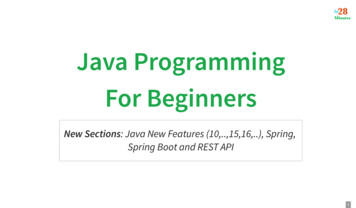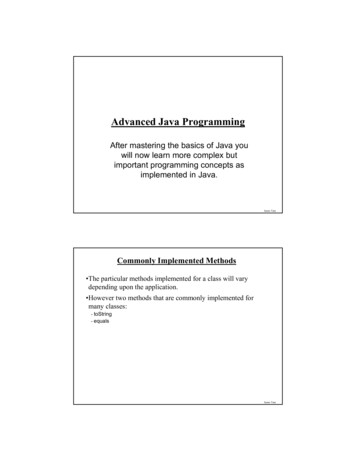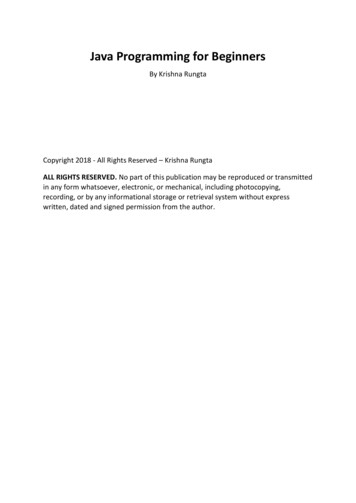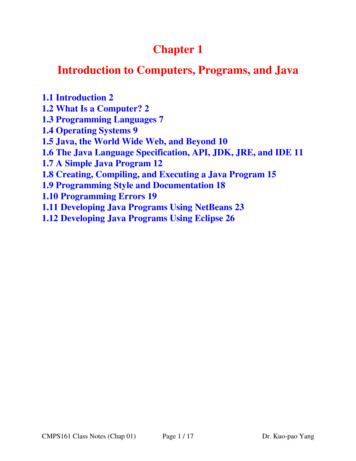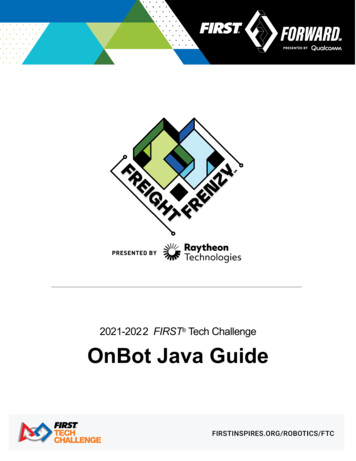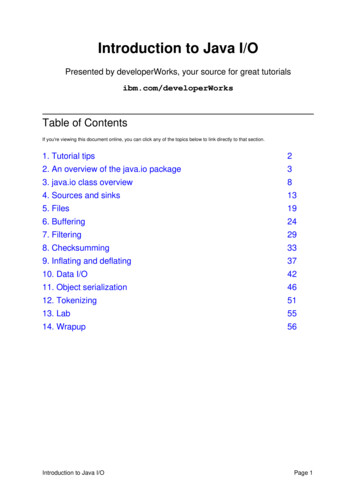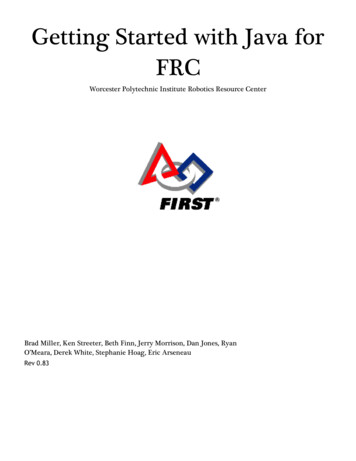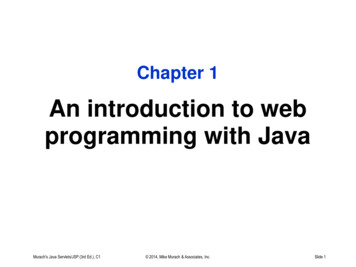
Transcription
Chapter 1An introduction to webprogramming with JavaMurach's Java Servlets/JSP (3rd Ed.), C1 2014, Mike Murach & Associates, Inc.Slide 1
ObjectivesKnowledge1. Name the software component that runs on the client of a typicalweb application.2. Name the two software components that run on the server of atypical web application.3. Distinguish between HTML and HTTP.4. Distinguish between static web pages and dynamic web pages.5. Name three approaches for developing Java web applications.6. Describe the software components that are required for developingservlet and JSP applications.7. List and describe the three layers of a typical Java web application.8. In general terms, describe the use of these directories as defined bythe J2EE specification: webapps, document root, WEB-INF, andWEB-INF\classes.Murach's Java Servlets/JSP (3rd Ed.), C1 2014, Mike Murach & Associates, Inc.Slide 2
Objectives (continued)9. Name two IDEs that can be used for developing Java webapplications.10. Name two web servers that can be used for developing Java webapplications.11. Name a popular database server that can be used for developingJava web applications.Murach's Java Servlets/JSP (3rd Ed.), C1 2014, Mike Murach & Associates, Inc.Slide 3
The first page of a shopping cart applicationMurach's Java Servlets/JSP (3rd Ed.), C1 2014, Mike Murach & Associates, Inc.Slide 4
The second page of a shopping cart applicationMurach's Java Servlets/JSP (3rd Ed.), C1 2014, Mike Murach & Associates, Inc.Slide 5
Components of a web nectionWebbrowserMurach's Java Servlets/JSP (3rd Ed.), C1Web serverDatabase server 2014, Mike Murach & Associates, Inc.Slide 6
How a web server processes static web pagesHow a web server processes dynamic web pagesMurach's Java Servlets/JSP (3rd Ed.), C1 2014, Mike Murach & Associates, Inc.Slide 7
Three approaches for developing Java web appsServlet/JSP Is a lower-level API that does less work for the programmer. Provides a high degree of control over the HTML/CSS/JavaScriptthat’s returned to the browser.JSF Is a higher-level API that does more work for the programmer. Makes it more difficult to control the HTML/CSS/JavaScriptthat’s returned to the browser.Spring Framework Is a higher-level API that does more work for the programmer. Provides a high degree of control over the HTML/CSS/JavaScriptthat’s returned to the browser.Murach's Java Servlets/JSP (3rd Ed.), C1 2014, Mike Murach & Associates, Inc.Slide 8
Terminology The Java Standard Edition (Java SE) includes the JavaDevelopment Kit (JDK) and the Java Runtime Environment (JRE). The Java Enterprise Edition (Java EE) specification describeshow web servers can interact with all Java web technologies. Servlets store the Java code that does the server-side processing. JavaServer Pages (JSPs) store the HTML that defines the userinterface. JavaServer Faces (JSF) provides a higher-level API that replacesboth servlets and JSPs. Java Persistence API (JPA) is an API for working with databases.Murach's Java Servlets/JSP (3rd Ed.), C1 2014, Mike Murach & Associates, Inc.Slide 9
The components of a servlet/JSP applicationMurach's Java Servlets/JSP (3rd Ed.), C1 2014, Mike Murach & Associates, Inc.Slide 10
The architecture for a servlet/JSP applicationMurach's Java Servlets/JSP (3rd Ed.), C1 2014, Mike Murach & Associates, Inc.Slide 11
The directory structure for a web applicationMurach's Java Servlets/JSP (3rd Ed.), C1 2014, Mike Murach & Associates, Inc.Slide 12
The directories and files for a web ins the HTML and JSP files.Contains the web.xml file and is not directlyaccessible from the web.\WEB-INF\classes Contains the servlets and other Java classes for yourapplication. Each subdirectory corresponds with thepackage for the Java class.\WEB-INF\libContains any JAR files that contain Java classlibraries that are used by the web application.\META-INFContains the context.xml file that configures theweb application context.Murach's Java Servlets/JSP (3rd Ed.), C1 2014, Mike Murach & Associates, Inc.Slide 13
The NetBeans IDEMurach's Java Servlets/JSP (3rd Ed.), C1 2014, Mike Murach & Associates, Inc.Slide 14
Popular IDEs for Java web development NetBeans Eclipse IntelliJ IDEAMurach's Java Servlets/JSP (3rd Ed.), C1 2014, Mike Murach & Associates, Inc.Slide 15
Two popular web serversTomcat Is a servlet/JSP engine that includes a web server. Is free, open-source, and runs on all modern operating systems. Is a popular web server for Java web applications.GlassFish Is a complete Java EE application server. Is free, open-source, and runs on all modern operating systems. Provides more features than Tomcat. Requires more system resources than Tomcat.Murach's Java Servlets/JSP (3rd Ed.), C1 2014, Mike Murach & Associates, Inc.Slide 16
Other popular web servers WildFly (formerly JBoss) Jetty Oracle WebLogic IBM WebSphereMurach's Java Servlets/JSP (3rd Ed.), C1 2014, Mike Murach & Associates, Inc.Slide 17
A popular database serverMySQL Is a relational database server that implements most of the SQLstandard. Is free, open-source, and runs on all modern operating systems. Is the most popular database server for Java web applications.Other popular database servers PostgreSQL OracleMurach's Java Servlets/JSP (3rd Ed.), C1 2014, Mike Murach & Associates, Inc.Slide 18
An ISP that provides servlet/JSP web hostingMurach's Java Servlets/JSP (3rd Ed.), C1 2014, Mike Murach & Associates, Inc.Slide 19
The FileZilla programMurach's Java Servlets/JSP (3rd Ed.), C1 2014, Mike Murach & Associates, Inc.Slide 20
\WEB-INF\classes Contains the servlets and other Java classes for your application. Each subdirectory corresponds with the package for the Java class. \WEB-INF\lib Contains any JAR files that contain Java class libraries that are used by the web application. \META-INF Contains the context.xml file that configures the web application context.



